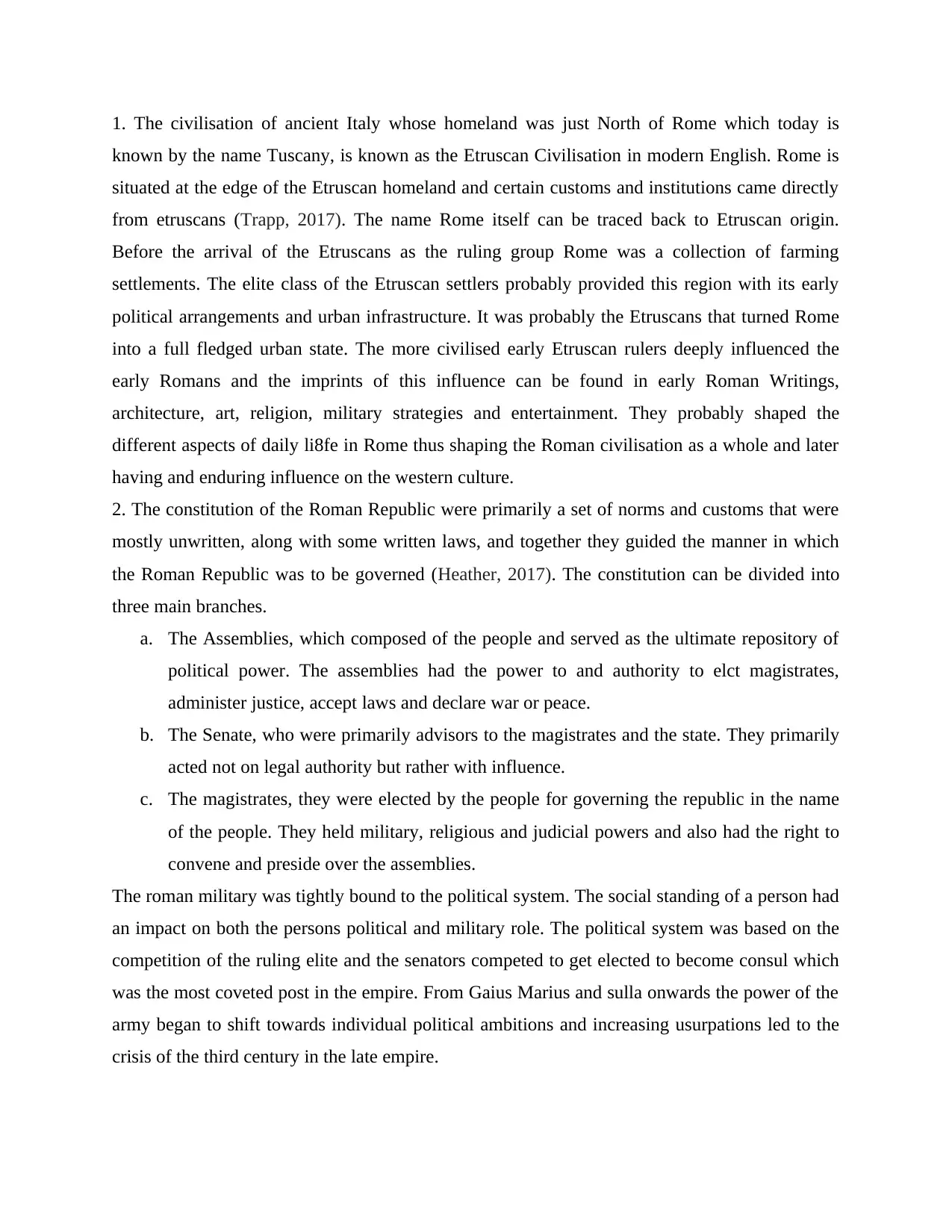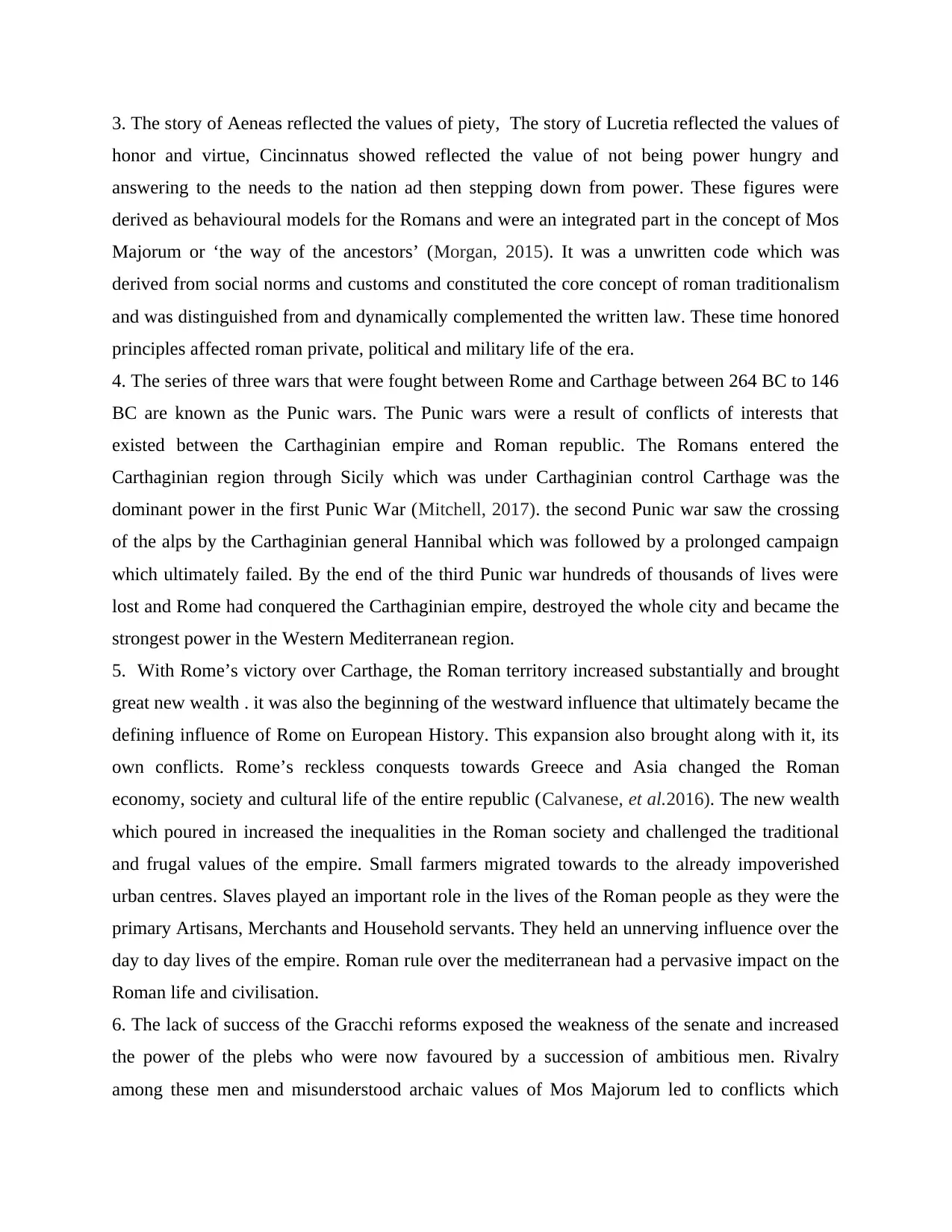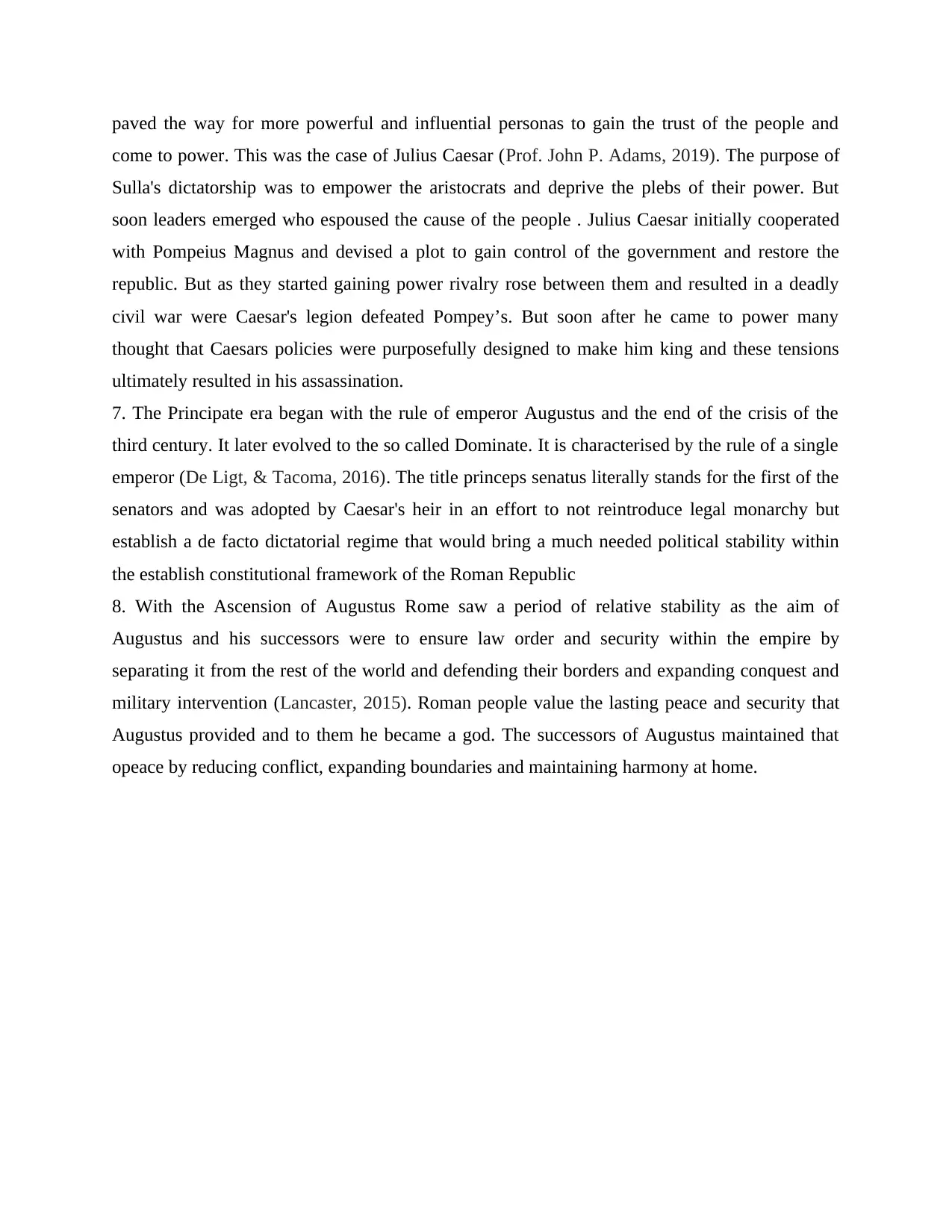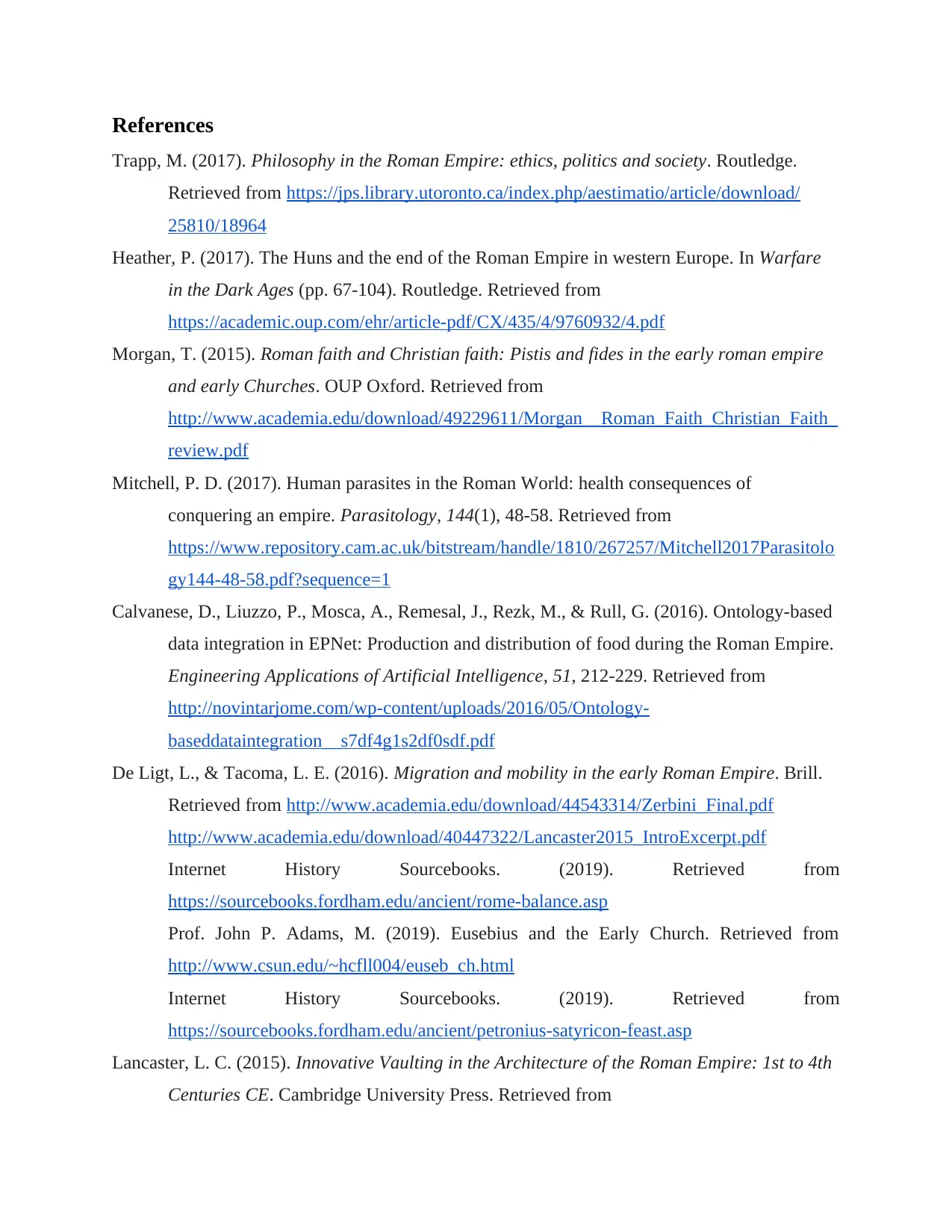Key Aspects of Roman History: From Republic to the Empire
VerifiedAdded on 2023/04/08
|6
|1378
|406
Essay
AI Summary
This essay provides an overview of key aspects of Roman history, beginning with the influence of the Etruscans on early Rome and the development of the Roman Republic's constitution. It explores the values reflected in Roman figures like Aeneas, Lucretia, and Cincinnatus, and discusses the Punic Wars and their impact on Rome's expansion and society. The essay also examines the Gracchi reforms, the rise of Julius Caesar, and the transition to the Principate era under Augustus, highlighting the political and social changes that shaped the Roman Empire and its lasting influence on Western civilization. Desklib provides more resources for students.

Roman History
Paraphrase This Document
Need a fresh take? Get an instant paraphrase of this document with our AI Paraphraser

1. The civilisation of ancient Italy whose homeland was just North of Rome which today is
known by the name Tuscany, is known as the Etruscan Civilisation in modern English. Rome is
situated at the edge of the Etruscan homeland and certain customs and institutions came directly
from etruscans (Trapp, 2017). The name Rome itself can be traced back to Etruscan origin.
Before the arrival of the Etruscans as the ruling group Rome was a collection of farming
settlements. The elite class of the Etruscan settlers probably provided this region with its early
political arrangements and urban infrastructure. It was probably the Etruscans that turned Rome
into a full fledged urban state. The more civilised early Etruscan rulers deeply influenced the
early Romans and the imprints of this influence can be found in early Roman Writings,
architecture, art, religion, military strategies and entertainment. They probably shaped the
different aspects of daily li8fe in Rome thus shaping the Roman civilisation as a whole and later
having and enduring influence on the western culture.
2. The constitution of the Roman Republic were primarily a set of norms and customs that were
mostly unwritten, along with some written laws, and together they guided the manner in which
the Roman Republic was to be governed (Heather, 2017). The constitution can be divided into
three main branches.
a. The Assemblies, which composed of the people and served as the ultimate repository of
political power. The assemblies had the power to and authority to elct magistrates,
administer justice, accept laws and declare war or peace.
b. The Senate, who were primarily advisors to the magistrates and the state. They primarily
acted not on legal authority but rather with influence.
c. The magistrates, they were elected by the people for governing the republic in the name
of the people. They held military, religious and judicial powers and also had the right to
convene and preside over the assemblies.
The roman military was tightly bound to the political system. The social standing of a person had
an impact on both the persons political and military role. The political system was based on the
competition of the ruling elite and the senators competed to get elected to become consul which
was the most coveted post in the empire. From Gaius Marius and sulla onwards the power of the
army began to shift towards individual political ambitions and increasing usurpations led to the
crisis of the third century in the late empire.
known by the name Tuscany, is known as the Etruscan Civilisation in modern English. Rome is
situated at the edge of the Etruscan homeland and certain customs and institutions came directly
from etruscans (Trapp, 2017). The name Rome itself can be traced back to Etruscan origin.
Before the arrival of the Etruscans as the ruling group Rome was a collection of farming
settlements. The elite class of the Etruscan settlers probably provided this region with its early
political arrangements and urban infrastructure. It was probably the Etruscans that turned Rome
into a full fledged urban state. The more civilised early Etruscan rulers deeply influenced the
early Romans and the imprints of this influence can be found in early Roman Writings,
architecture, art, religion, military strategies and entertainment. They probably shaped the
different aspects of daily li8fe in Rome thus shaping the Roman civilisation as a whole and later
having and enduring influence on the western culture.
2. The constitution of the Roman Republic were primarily a set of norms and customs that were
mostly unwritten, along with some written laws, and together they guided the manner in which
the Roman Republic was to be governed (Heather, 2017). The constitution can be divided into
three main branches.
a. The Assemblies, which composed of the people and served as the ultimate repository of
political power. The assemblies had the power to and authority to elct magistrates,
administer justice, accept laws and declare war or peace.
b. The Senate, who were primarily advisors to the magistrates and the state. They primarily
acted not on legal authority but rather with influence.
c. The magistrates, they were elected by the people for governing the republic in the name
of the people. They held military, religious and judicial powers and also had the right to
convene and preside over the assemblies.
The roman military was tightly bound to the political system. The social standing of a person had
an impact on both the persons political and military role. The political system was based on the
competition of the ruling elite and the senators competed to get elected to become consul which
was the most coveted post in the empire. From Gaius Marius and sulla onwards the power of the
army began to shift towards individual political ambitions and increasing usurpations led to the
crisis of the third century in the late empire.

3. The story of Aeneas reflected the values of piety, The story of Lucretia reflected the values of
honor and virtue, Cincinnatus showed reflected the value of not being power hungry and
answering to the needs to the nation ad then stepping down from power. These figures were
derived as behavioural models for the Romans and were an integrated part in the concept of Mos
Majorum or ‘the way of the ancestors’ (Morgan, 2015). It was a unwritten code which was
derived from social norms and customs and constituted the core concept of roman traditionalism
and was distinguished from and dynamically complemented the written law. These time honored
principles affected roman private, political and military life of the era.
4. The series of three wars that were fought between Rome and Carthage between 264 BC to 146
BC are known as the Punic wars. The Punic wars were a result of conflicts of interests that
existed between the Carthaginian empire and Roman republic. The Romans entered the
Carthaginian region through Sicily which was under Carthaginian control Carthage was the
dominant power in the first Punic War (Mitchell, 2017). the second Punic war saw the crossing
of the alps by the Carthaginian general Hannibal which was followed by a prolonged campaign
which ultimately failed. By the end of the third Punic war hundreds of thousands of lives were
lost and Rome had conquered the Carthaginian empire, destroyed the whole city and became the
strongest power in the Western Mediterranean region.
5. With Rome’s victory over Carthage, the Roman territory increased substantially and brought
great new wealth . it was also the beginning of the westward influence that ultimately became the
defining influence of Rome on European History. This expansion also brought along with it, its
own conflicts. Rome’s reckless conquests towards Greece and Asia changed the Roman
economy, society and cultural life of the entire republic (Calvanese, et al.2016). The new wealth
which poured in increased the inequalities in the Roman society and challenged the traditional
and frugal values of the empire. Small farmers migrated towards to the already impoverished
urban centres. Slaves played an important role in the lives of the Roman people as they were the
primary Artisans, Merchants and Household servants. They held an unnerving influence over the
day to day lives of the empire. Roman rule over the mediterranean had a pervasive impact on the
Roman life and civilisation.
6. The lack of success of the Gracchi reforms exposed the weakness of the senate and increased
the power of the plebs who were now favoured by a succession of ambitious men. Rivalry
among these men and misunderstood archaic values of Mos Majorum led to conflicts which
honor and virtue, Cincinnatus showed reflected the value of not being power hungry and
answering to the needs to the nation ad then stepping down from power. These figures were
derived as behavioural models for the Romans and were an integrated part in the concept of Mos
Majorum or ‘the way of the ancestors’ (Morgan, 2015). It was a unwritten code which was
derived from social norms and customs and constituted the core concept of roman traditionalism
and was distinguished from and dynamically complemented the written law. These time honored
principles affected roman private, political and military life of the era.
4. The series of three wars that were fought between Rome and Carthage between 264 BC to 146
BC are known as the Punic wars. The Punic wars were a result of conflicts of interests that
existed between the Carthaginian empire and Roman republic. The Romans entered the
Carthaginian region through Sicily which was under Carthaginian control Carthage was the
dominant power in the first Punic War (Mitchell, 2017). the second Punic war saw the crossing
of the alps by the Carthaginian general Hannibal which was followed by a prolonged campaign
which ultimately failed. By the end of the third Punic war hundreds of thousands of lives were
lost and Rome had conquered the Carthaginian empire, destroyed the whole city and became the
strongest power in the Western Mediterranean region.
5. With Rome’s victory over Carthage, the Roman territory increased substantially and brought
great new wealth . it was also the beginning of the westward influence that ultimately became the
defining influence of Rome on European History. This expansion also brought along with it, its
own conflicts. Rome’s reckless conquests towards Greece and Asia changed the Roman
economy, society and cultural life of the entire republic (Calvanese, et al.2016). The new wealth
which poured in increased the inequalities in the Roman society and challenged the traditional
and frugal values of the empire. Small farmers migrated towards to the already impoverished
urban centres. Slaves played an important role in the lives of the Roman people as they were the
primary Artisans, Merchants and Household servants. They held an unnerving influence over the
day to day lives of the empire. Roman rule over the mediterranean had a pervasive impact on the
Roman life and civilisation.
6. The lack of success of the Gracchi reforms exposed the weakness of the senate and increased
the power of the plebs who were now favoured by a succession of ambitious men. Rivalry
among these men and misunderstood archaic values of Mos Majorum led to conflicts which
⊘ This is a preview!⊘
Do you want full access?
Subscribe today to unlock all pages.

Trusted by 1+ million students worldwide

paved the way for more powerful and influential personas to gain the trust of the people and
come to power. This was the case of Julius Caesar (Prof. John P. Adams, 2019). The purpose of
Sulla's dictatorship was to empower the aristocrats and deprive the plebs of their power. But
soon leaders emerged who espoused the cause of the people . Julius Caesar initially cooperated
with Pompeius Magnus and devised a plot to gain control of the government and restore the
republic. But as they started gaining power rivalry rose between them and resulted in a deadly
civil war were Caesar's legion defeated Pompey’s. But soon after he came to power many
thought that Caesars policies were purposefully designed to make him king and these tensions
ultimately resulted in his assassination.
7. The Principate era began with the rule of emperor Augustus and the end of the crisis of the
third century. It later evolved to the so called Dominate. It is characterised by the rule of a single
emperor (De Ligt, & Tacoma, 2016). The title princeps senatus literally stands for the first of the
senators and was adopted by Caesar's heir in an effort to not reintroduce legal monarchy but
establish a de facto dictatorial regime that would bring a much needed political stability within
the establish constitutional framework of the Roman Republic
8. With the Ascension of Augustus Rome saw a period of relative stability as the aim of
Augustus and his successors were to ensure law order and security within the empire by
separating it from the rest of the world and defending their borders and expanding conquest and
military intervention (Lancaster, 2015). Roman people value the lasting peace and security that
Augustus provided and to them he became a god. The successors of Augustus maintained that
opeace by reducing conflict, expanding boundaries and maintaining harmony at home.
come to power. This was the case of Julius Caesar (Prof. John P. Adams, 2019). The purpose of
Sulla's dictatorship was to empower the aristocrats and deprive the plebs of their power. But
soon leaders emerged who espoused the cause of the people . Julius Caesar initially cooperated
with Pompeius Magnus and devised a plot to gain control of the government and restore the
republic. But as they started gaining power rivalry rose between them and resulted in a deadly
civil war were Caesar's legion defeated Pompey’s. But soon after he came to power many
thought that Caesars policies were purposefully designed to make him king and these tensions
ultimately resulted in his assassination.
7. The Principate era began with the rule of emperor Augustus and the end of the crisis of the
third century. It later evolved to the so called Dominate. It is characterised by the rule of a single
emperor (De Ligt, & Tacoma, 2016). The title princeps senatus literally stands for the first of the
senators and was adopted by Caesar's heir in an effort to not reintroduce legal monarchy but
establish a de facto dictatorial regime that would bring a much needed political stability within
the establish constitutional framework of the Roman Republic
8. With the Ascension of Augustus Rome saw a period of relative stability as the aim of
Augustus and his successors were to ensure law order and security within the empire by
separating it from the rest of the world and defending their borders and expanding conquest and
military intervention (Lancaster, 2015). Roman people value the lasting peace and security that
Augustus provided and to them he became a god. The successors of Augustus maintained that
opeace by reducing conflict, expanding boundaries and maintaining harmony at home.
Paraphrase This Document
Need a fresh take? Get an instant paraphrase of this document with our AI Paraphraser

References
Trapp, M. (2017). Philosophy in the Roman Empire: ethics, politics and society. Routledge.
Retrieved from https://jps.library.utoronto.ca/index.php/aestimatio/article/download/
25810/18964
Heather, P. (2017). The Huns and the end of the Roman Empire in western Europe. In Warfare
in the Dark Ages (pp. 67-104). Routledge. Retrieved from
https://academic.oup.com/ehr/article-pdf/CX/435/4/9760932/4.pdf
Morgan, T. (2015). Roman faith and Christian faith: Pistis and fides in the early roman empire
and early Churches. OUP Oxford. Retrieved from
http://www.academia.edu/download/49229611/Morgan__Roman_Faith_Christian_Faith_
review.pdf
Mitchell, P. D. (2017). Human parasites in the Roman World: health consequences of
conquering an empire. Parasitology, 144(1), 48-58. Retrieved from
https://www.repository.cam.ac.uk/bitstream/handle/1810/267257/Mitchell2017Parasitolo
gy144-48-58.pdf?sequence=1
Calvanese, D., Liuzzo, P., Mosca, A., Remesal, J., Rezk, M., & Rull, G. (2016). Ontology-based
data integration in EPNet: Production and distribution of food during the Roman Empire.
Engineering Applications of Artificial Intelligence, 51, 212-229. Retrieved from
http://novintarjome.com/wp-content/uploads/2016/05/Ontology-
baseddataintegration__s7df4g1s2df0sdf.pdf
De Ligt, L., & Tacoma, L. E. (2016). Migration and mobility in the early Roman Empire. Brill.
Retrieved from http://www.academia.edu/download/44543314/Zerbini_Final.pdf
http://www.academia.edu/download/40447322/Lancaster2015_IntroExcerpt.pdf
Internet History Sourcebooks. (2019). Retrieved from
https://sourcebooks.fordham.edu/ancient/rome-balance.asp
Prof. John P. Adams, M. (2019). Eusebius and the Early Church. Retrieved from
http://www.csun.edu/~hcfll004/euseb_ch.html
Internet History Sourcebooks. (2019). Retrieved from
https://sourcebooks.fordham.edu/ancient/petronius-satyricon-feast.asp
Lancaster, L. C. (2015). Innovative Vaulting in the Architecture of the Roman Empire: 1st to 4th
Centuries CE. Cambridge University Press. Retrieved from
Trapp, M. (2017). Philosophy in the Roman Empire: ethics, politics and society. Routledge.
Retrieved from https://jps.library.utoronto.ca/index.php/aestimatio/article/download/
25810/18964
Heather, P. (2017). The Huns and the end of the Roman Empire in western Europe. In Warfare
in the Dark Ages (pp. 67-104). Routledge. Retrieved from
https://academic.oup.com/ehr/article-pdf/CX/435/4/9760932/4.pdf
Morgan, T. (2015). Roman faith and Christian faith: Pistis and fides in the early roman empire
and early Churches. OUP Oxford. Retrieved from
http://www.academia.edu/download/49229611/Morgan__Roman_Faith_Christian_Faith_
review.pdf
Mitchell, P. D. (2017). Human parasites in the Roman World: health consequences of
conquering an empire. Parasitology, 144(1), 48-58. Retrieved from
https://www.repository.cam.ac.uk/bitstream/handle/1810/267257/Mitchell2017Parasitolo
gy144-48-58.pdf?sequence=1
Calvanese, D., Liuzzo, P., Mosca, A., Remesal, J., Rezk, M., & Rull, G. (2016). Ontology-based
data integration in EPNet: Production and distribution of food during the Roman Empire.
Engineering Applications of Artificial Intelligence, 51, 212-229. Retrieved from
http://novintarjome.com/wp-content/uploads/2016/05/Ontology-
baseddataintegration__s7df4g1s2df0sdf.pdf
De Ligt, L., & Tacoma, L. E. (2016). Migration and mobility in the early Roman Empire. Brill.
Retrieved from http://www.academia.edu/download/44543314/Zerbini_Final.pdf
http://www.academia.edu/download/40447322/Lancaster2015_IntroExcerpt.pdf
Internet History Sourcebooks. (2019). Retrieved from
https://sourcebooks.fordham.edu/ancient/rome-balance.asp
Prof. John P. Adams, M. (2019). Eusebius and the Early Church. Retrieved from
http://www.csun.edu/~hcfll004/euseb_ch.html
Internet History Sourcebooks. (2019). Retrieved from
https://sourcebooks.fordham.edu/ancient/petronius-satyricon-feast.asp
Lancaster, L. C. (2015). Innovative Vaulting in the Architecture of the Roman Empire: 1st to 4th
Centuries CE. Cambridge University Press. Retrieved from

⊘ This is a preview!⊘
Do you want full access?
Subscribe today to unlock all pages.

Trusted by 1+ million students worldwide
1 out of 6
Your All-in-One AI-Powered Toolkit for Academic Success.
+13062052269
info@desklib.com
Available 24*7 on WhatsApp / Email
![[object Object]](/_next/static/media/star-bottom.7253800d.svg)
Unlock your academic potential
Copyright © 2020–2025 A2Z Services. All Rights Reserved. Developed and managed by ZUCOL.
